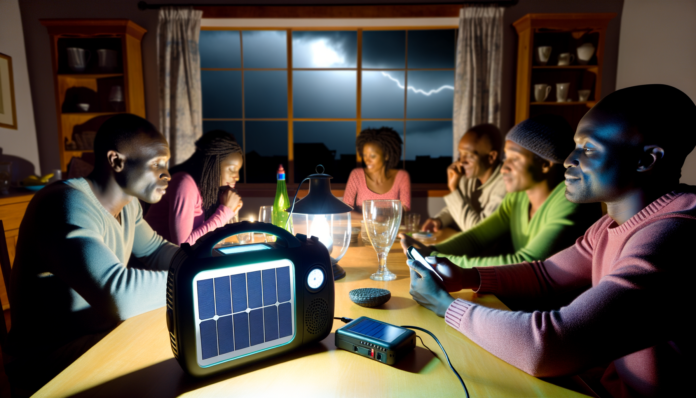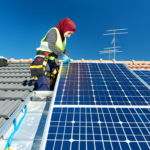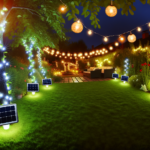Introduction
The Importance of Emergency Solar Power Kits
In an era where power outages are becoming increasingly common due to natural disasters, aging infrastructure, and other unforeseen events, having a reliable backup power source is crucial. Emergency solar power kits offer a sustainable and efficient solution to keep your essential devices running when the grid goes down. Unlike traditional gas-powered generators, solar power kits are clean, quiet, and require minimal maintenance. They harness the power of the sun, providing a renewable energy source that can be used indefinitely, making them an invaluable asset during emergencies.
Who Can Benefit from These Kits?
Emergency solar power kits are not just for the environmentally conscious; they are beneficial for a wide range of individuals and scenarios:
- Homeowners: Ensure that your household remains functional during power outages, keeping essential appliances like refrigerators, medical devices, and communication tools operational.
- Outdoor Enthusiasts: Campers, hikers, and adventurers can use these kits to power their devices in remote locations, far from the nearest power outlet.
- Businesses: Small businesses can maintain critical operations during blackouts, preventing data loss and ensuring customer service continuity.
- Emergency Responders: First responders and disaster relief teams can use portable solar power kits to support their operations in areas affected by natural disasters.
What to Expect in This Article
This article aims to provide a comprehensive guide to emergency solar power kits, covering everything you need to know to make an informed decision. Here’s what you can expect:
- Understanding Emergency Solar Power Kits: We will explain what these kits are, their key components, and how they work.
- Criteria for Selecting the Best Solar Power Kits: Learn about the essential factors to consider, such as portability, power output, durability, and additional features.
- Top Emergency Solar Power Kits: A detailed review of the top five solar power kits available on the market, highlighting their features and benefits.
- How to Use and Maintain Your Solar Power Kit: Practical tips on setting up, maximizing efficiency, and maintaining your kit to ensure long-term reliability.
- Benefits of Using Solar Power Kits: Discover the environmental, financial, and practical advantages of using solar power for emergency preparedness.
- Conclusion: A recap of key points, final thoughts, and recommendations to help you choose the best solar power solution for your needs.
By the end of this article, you will have a thorough understanding of emergency solar power kits and be well-equipped to select the best option to keep your lights on during any power outage.
Understanding Emergency Solar Power Kits
What Are Emergency Solar Power Kits?
Emergency solar power kits are comprehensive systems designed to provide reliable electricity during power outages or in off-grid situations. These kits harness the energy from the sun and convert it into usable electrical power, ensuring that essential devices and appliances remain operational when traditional power sources are unavailable. They are particularly useful in scenarios such as natural disasters, severe weather events, or any situation where the power grid is compromised.
Key Components of a Solar Power Kit
An emergency solar power kit typically includes several essential components:
- Solar Panels: These are the primary devices that capture sunlight and convert it into direct current (DC) electricity. They are usually made of monocrystalline or polycrystalline silicon.
- Solar Generator: This device converts the DC power generated by the solar panels into alternating current (AC) power, which is the standard form of electricity used by most household appliances.
- Battery Storage: Batteries store the electricity generated by the solar panels for use when sunlight is not available, such as during nighttime or cloudy days.
- Charge Controller: This component regulates the voltage and current coming from the solar panels to prevent overcharging the batteries.
- Cables and Connectors: These are necessary for connecting the various components of the kit, ensuring a seamless flow of electricity.
- Mounting Hardware: This includes brackets and stands used to securely position the solar panels for optimal sunlight exposure.
How Do They Work?
The operation of an emergency solar power kit can be broken down into a few simple steps:
- Sunlight Absorption: Solar panels absorb sunlight and convert it into DC electricity. The efficiency of this process depends on the quality of the solar panels and the amount of sunlight they receive.
- Power Conversion: The DC electricity generated by the solar panels is sent to the solar generator, which converts it into AC electricity. This conversion is crucial because most household appliances and devices operate on AC power.
- Energy Storage: The converted AC electricity is either used immediately to power devices or stored in batteries for later use. The charge controller ensures that the batteries are charged efficiently and safely.
- Power Distribution: The stored electricity can be used to power various devices and appliances through the generator’s outlets. Some advanced kits also come with multiple output options, including USB ports and DC outlets, to accommodate different types of devices.
By understanding these components and their functions, users can effectively utilize emergency solar power kits to maintain a reliable power supply during critical times. These kits not only provide a sustainable energy solution but also offer peace of mind in emergency situations.
Criteria for Selecting the Best Solar Power Kits
Portability and Ease of Use
When selecting an emergency solar power kit, **portability** is a crucial factor. The kit should be lightweight and compact enough to be easily transported, whether you’re moving it around your home, taking it on a camping trip, or using it at a remote worksite. Look for kits that come with carrying handles or wheels for added convenience. Additionally, the setup process should be straightforward, with clear instructions and minimal tools required. Kits that offer plug-and-play functionality can save you time and effort, making them ideal for emergency situations where quick deployment is essential.
Power Output and Capacity
The **power output and capacity** of a solar power kit determine how many devices you can run and for how long. This is typically measured in watt-hours (Wh) for the battery and watts (W) for the solar panels. Higher capacity kits can power more demanding appliances like refrigerators, medical equipment, or multiple devices simultaneously. For instance, the Jackery Solar Generator 2000 Pro offers a substantial capacity of 2,160 Wh, making it suitable for more extensive power needs. Assess your energy requirements and choose a kit that can meet those demands without frequent recharging.
Durability and Weather Resistance
**Durability** and **weather resistance** are vital, especially if you plan to use the kit outdoors or in harsh conditions. Look for kits with robust, weather-resistant materials that can withstand rain, wind, and extreme temperatures. Solar panels should have a high efficiency rating and be made from durable materials like tempered glass and aluminum frames. The Jackery SolarSaga 200 panels, for example, boast a 24.3% efficiency rating and are designed to endure various weather conditions, ensuring reliable performance when you need it most.
Battery Storage and Efficiency
The **battery storage** capacity and **efficiency** of a solar power kit are critical for ensuring you have power when you need it. Efficient batteries can store more energy and retain it longer, providing a reliable power source during extended outages. Lithium-ion batteries are generally preferred for their high energy density, longer lifespan, and faster charging times. Kits like the Bluetti EB3A, which can recharge in just 81 minutes, offer excellent efficiency and quick turnaround times, making them ideal for emergency use.
Additional Features and Accessories
Finally, consider the **additional features and accessories** that come with the solar power kit. These can enhance the kit’s functionality and convenience. Look for features like multiple output ports (USB-A, USB-C, AC outlets, and 12-volt car ports), built-in lights, and informative displays that show battery status and power usage. Some kits also offer wireless charging capabilities, which can be a handy addition. Accessories like extra solar panels, carrying cases, and extension cables can also add value and flexibility to your setup.
By considering these criteria—portability, power output, durability, battery efficiency, and additional features—you can select the best emergency solar power kit to keep your lights on and your devices running during any power outage.
Top Emergency Solar Power Kits
Kit 1: Overview and Features
The **Jackery Solar Generator 2000 Pro** is a standout in the realm of emergency solar power kits. This kit includes the Jackery Explorer 2000 Pro portable power station and the Jackery SolarSaga 200 solar panels. The combination is known for its fast charging capabilities, reaching 100% charge from an AC wall outlet in just under 2 hours. When using solar power, it can achieve full charge in approximately 2.5 hours with six solar panels. The generator boasts a maximum solar input of 1,400 watts, significantly higher than its competitors. It features a user-friendly display and multiple outlets, including USB-A, USB-C, AC plugs, and 12-volt car ports. Despite its hefty capacity, it is relatively lightweight, making it easier to transport.
Kit 2: Overview and Features
The **Bluetti EB3A** is another top contender, particularly noted for its rapid charging times. It can reach a full charge in just 81 minutes when plugged into a wall outlet. The Bluetti PV200 portable solar panel, with an efficiency of up to 23.4%, can recharge the generator in under 2 hours under ideal conditions. The generator’s display is comprehensive, showing detailed information about power flow and output status. With a maximum solar input of 200 watts, it combines well with AC charging to reach a total charging capacity of 430 watts. This kit is ideal for those who need a quick and efficient power solution.
Kit 3: Overview and Features
The **Oupes 600W Solar Generator Kit** offers excellent value for money. It includes a 595 watt-hour battery and a 100-watt solar panel. Despite its lower efficiency rating of 20%, it provides close to one watt per dollar spent, making it a cost-effective option. The Oupes generator features a user-friendly display and a variety of ports, including USB-A, USB-C, 12-volt car charger, and AC wall outlet. While it charges slower than some competitors and can only connect one solar panel at a time, its affordability and functionality make it a solid choice for budget-conscious users.
Kit 4: Overview and Features
The **EcoFlow Delta Mini** is a robust midsize solar generator with an 882 watt-hour battery. It charges twice as fast as its competitors from a wall outlet, reaching full charge in just 97 minutes. The generator supports up to 300 watts of solar charging, allowing for relatively quick recharges on the go. It features five AC wall-style outlets, two USB-A ports, a USB-A fast charging port, a USB-C outlet, and a 12.6-volt car power outlet. Weighing 23.6 pounds, it strikes a balance between portability and power capacity. The Delta Mini is ideal for powering small appliances and offers a high level of versatility.
Kit 5: Overview and Features
The **Geneverse HomePower Pro Solar Generator** is a sleek and efficient option. It features a 1,200 watt-hour capacity and can accommodate up to 800 watts of solar charging. This allows for faster solar recharges compared to many other models. The generator includes multiple ports, such as USB-A, USB-C, and AC outlets, and has a user-friendly display. Geneverse solar panels boast efficiency ratings above 23%, making them highly effective. This kit is perfect for those who need a reliable and fast-charging solar generator for various applications.
Each of these kits offers unique features and benefits, catering to different needs and budgets. Whether you prioritize fast charging, value for money, or portability, there is an emergency solar power kit that will meet your requirements.
How to Use and Maintain Your Solar Power Kit
Setting Up Your Kit
Setting up your emergency solar power kit is a straightforward process, but it requires careful attention to detail to ensure optimal performance. Here are the steps to follow:
1. **Choose the Right Location**: Place your solar panels in an area with maximum exposure to sunlight. Ideally, this should be a spot that receives direct sunlight for most of the day.
2. **Assemble the Panels**: If your kit includes foldable or portable panels, unfold and position them securely. For rigid panels, use the provided mounting brackets to fix them in place.
3. **Connect the Panels to the Generator**: Use the cables provided in your kit to connect the solar panels to the solar generator. Ensure all connections are secure and follow the manufacturer’s instructions.
4. **Power Up Your Devices**: Once the generator is charged, you can plug in your devices and appliances. Use the appropriate outlets and cables to avoid overloading the system.
Maximizing Efficiency
To get the most out of your solar power kit, consider these tips for maximizing efficiency:
– **Optimal Panel Placement**: Adjust the angle of your solar panels to capture the most sunlight. This may vary depending on the time of year and your geographical location.
– **Regular Cleaning**: Dust, dirt, and debris can reduce the efficiency of your solar panels. Clean them regularly with a soft cloth and mild detergent.
– **Monitor Battery Levels**: Keep an eye on the battery levels of your solar generator. Avoid letting the battery drain completely, as this can reduce its lifespan.
– **Energy Management**: Prioritize the use of essential devices and appliances to ensure you have power when you need it most. Turn off devices when not in use to conserve energy.
Routine Maintenance Tips
Routine maintenance is crucial for the longevity and reliability of your solar power kit. Here are some maintenance tips:
– **Inspect Connections**: Regularly check all electrical connections for signs of wear or corrosion. Tighten any loose connections and replace damaged cables.
– **Battery Care**: Follow the manufacturer’s guidelines for battery maintenance. This may include periodic charging cycles and storage recommendations.
– **Panel Inspection**: Inspect your solar panels for any physical damage, such as cracks or scratches. Address any issues promptly to maintain efficiency.
– **Firmware Updates**: If your solar generator has firmware, check for updates periodically. Manufacturers often release updates to improve performance and fix bugs.
Troubleshooting Common Issues
Even with proper setup and maintenance, you may encounter some common issues with your solar power kit. Here’s how to troubleshoot them:
– **Low Power Output**: If your system is not generating enough power, check the panel placement and ensure they are not shaded. Clean the panels and check all connections.
– **Battery Not Charging**: If the battery is not charging, inspect the cables and connections between the panels and the generator. Ensure the panels are receiving adequate sunlight.
– **Device Not Powering On**: If a connected device is not powering on, check the generator’s output settings and ensure the device is compatible with the generator’s power capacity.
– **Error Messages**: Refer to the user manual for any error messages displayed on the generator. Follow the troubleshooting steps provided by the manufacturer.
By following these guidelines, you can ensure that your emergency solar power kit remains a reliable source of power during outages and other emergencies. Regular maintenance and proper usage will help you get the most out of your investment, providing peace of mind and energy independence.
Benefits of Using Solar Power Kits
Environmental Impact
One of the most compelling benefits of using solar power kits is their positive impact on the environment. Traditional generators rely on fossil fuels, which emit harmful pollutants and contribute to climate change. In contrast, solar power harnesses energy from the sun, a clean and renewable resource. By using solar power kits, you reduce your carbon footprint and help decrease the overall demand for fossil fuels. This shift not only mitigates air pollution but also conserves natural resources, promoting a healthier planet for future generations.
Cost Savings Over Time
While the initial investment in a solar power kit may seem high, the long-term financial benefits are substantial. Once installed, solar power systems have minimal operating costs. Sunlight is free, and modern solar panels require little maintenance. Over time, the savings on electricity bills can be significant. Additionally, many regions offer tax incentives, rebates, and other financial benefits for adopting solar energy, further reducing the overall cost. In the event of a power outage, having a solar power kit can also save you money by preventing the spoilage of food and other perishables, as well as avoiding the costs associated with temporary relocation or emergency accommodations.
Independence from the Grid
Solar power kits provide a level of energy independence that is particularly valuable during emergencies. When the grid goes down due to extreme weather or other disruptions, a solar power kit can keep your essential devices and appliances running. This independence ensures that you have a reliable source of power for heating, cooling, communication, and other critical needs. Moreover, for those living in remote areas where grid access is limited or unreliable, solar power kits offer a viable and sustainable alternative to traditional power sources.
Versatility for Various Activities
The versatility of solar power kits extends beyond emergency preparedness. These kits are ideal for a wide range of activities and settings. Whether you’re camping, RVing, boating, or hosting an outdoor event, a portable solar power kit can provide the electricity you need without the noise and fumes of a gas generator. Solar power kits are also useful for powering tools and equipment in off-grid construction sites or remote work locations. Their portability and ease of use make them a convenient solution for any situation where access to electricity is limited or unavailable.
In summary, the benefits of using solar power kits are manifold. They offer a clean, renewable source of energy that reduces environmental impact, provides significant cost savings over time, ensures independence from the grid, and offers versatile applications for various activities. Investing in a solar power kit is not only a smart choice for emergency preparedness but also a step towards a more sustainable and self-sufficient lifestyle.
Conclusion
Recap of Key Points
In this article, we have explored the critical role that emergency solar power kits play in ensuring a reliable power source during unexpected outages. We began by understanding what these kits are and how they work, delving into their key components such as solar panels, generators, and batteries. We then discussed the essential criteria for selecting the best solar power kits, including portability, power output, durability, and additional features. Following this, we reviewed the top five emergency solar power kits available on the market, highlighting their unique features and benefits. Finally, we provided practical advice on how to use and maintain these kits to maximize their efficiency and longevity.
Final Thoughts and Recommendations
Investing in an emergency solar power kit is a proactive step towards energy independence and security. These kits not only provide a sustainable and eco-friendly power solution but also offer peace of mind during emergencies. When selecting a kit, consider your specific needs, such as the number of devices you need to power, the duration of potential outages, and the portability requirements. Brands like EcoFlow, Bluetti, and Jackery offer a range of options that cater to different needs and budgets. It is also crucial to follow the setup and maintenance guidelines to ensure your kit performs optimally when you need it the most.
Encouragement to Explore Solar Solutions
The increasing frequency of power outages and the growing awareness of environmental sustainability make now the perfect time to explore solar solutions. Emergency solar power kits are not just for extreme situations; they are versatile tools that can be used for camping, outdoor activities, and even as a supplementary power source for your home. By investing in a solar power kit, you are taking a significant step towards reducing your carbon footprint and embracing renewable energy. We encourage you to explore the various options available and choose a kit that best suits your needs. Remember, the sun is a powerful and free resource—harness it to keep your lights on and your devices running, no matter what challenges come your way.






